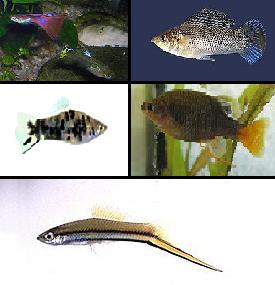Livebearing fish: Difference between revisions
imported>Drew R. Smith No edit summary |
imported>Drew R. Smith |
||
| Line 1: | Line 1: | ||
<noinclude>{{subpages}}</noinclude><includeonly> | <noinclude>{{subpages}}</noinclude><includeonly> | ||
====Tropical livebearers==== | ====Tropical livebearers==== | ||
</includeonly>[[image:tropicallivebearers.jpg| | </includeonly>[[image:tropicallivebearers.jpg|300px|Clockwise from top-left: [[Guppy]], [[Molly]], [[Goodied]], [[Swordtail]], and [[Platy]]]] | ||
Livebearing fishes are native to the Americas, from New Jersey down to Brazil, and in east Asia. They have been introduced into other tropical areas to combat malaria, as livebearers eat the waterborne larvae of disease-carrying mosquitoes. | Livebearing fishes are native to the Americas, from New Jersey down to Brazil, and in east Asia. They have been introduced into other tropical areas to combat malaria, as livebearers eat the waterborne larvae of disease-carrying mosquitoes. | ||
Revision as of 01:33, 9 September 2009
Livebearing fishes are native to the Americas, from New Jersey down to Brazil, and in east Asia. They have been introduced into other tropical areas to combat malaria, as livebearers eat the waterborne larvae of disease-carrying mosquitoes.
Females are usually longer than males, but the latter have more striking colors and patterns, and often have longer fins. Most livebearers adapt well to the aquarium and will thrive in hard water. Feeding is uncomplicated, but these fishes appreciate the addition of vegetable matter.
A main attraction of these fishes is their propensity to breed in captivity, especially the brilliantly colored, aquarium-developed strains of guppies, mollies, platys, and swordtails. It is advisable to move a gravid female into a separate nursery tank for birthing. This should be heavily planted to shield the young from their hungry mother.
